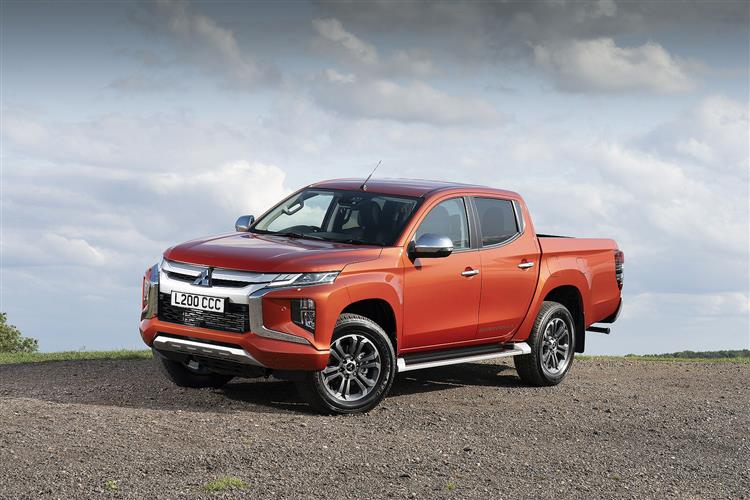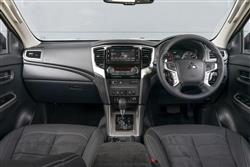How will you view?
This is a sample, showing 30 seconds of each section.
ONE L OF A PICK-UP? (some text hidden) new_mitsubishil200series6_2019
By Jonathan Crouch
Introductionword count: 97
This smarter Series 6 version of the Mitsubishi L200 pick-up was the last sold before the brand pulled out of the UK market at the end of 2021. It shared much with its predecessor but also featured significant changes. Mitsubishi claimed that it was the most advanced version of this model it had made, being smarter, safer and able to tow more. It could also carry heavier weights and was nicer to sit in, plus it was better equipped, more efficient and remained sensibly priced. You can see why so many buyers in this segment choose it.
Modelsword count: 5
Pick-up - 2.3 diesel 150PS
Historyword count: 492
If you're buying a used pick-up in the UK, then it's highly likely that you'll be looking at Mitsubishi's L200. This model when new did, after all, historically out-sell all its rivals, especially in the UK, which during the L200 model's lifetime accounted for virtually half of all versions of this model sold in Europe. So, back in 2019, the brand felt it was well set for British sales success when introducing to the market a version of this pick-up that was smarter, even more capable, better equipped and more efficient. All of this we were promised with the L200 Series 6. By 2019, globally Mitsubishi had amassed over four decades of pick-up production experience and had sold well over 4.7 million of them, mostly using L200 badging, a model range first launched here way back in 1982, then updated in 1986. It was the 'Series 3' third generation version we first saw in 1996 though, that really hit the big time for this Japanese brand, a model later credited with the rejuvenation of the entire market segment. It was the first to recognise that the pick-up needn't be merely a utilitarian workhorse fit only for farmers and jobbing builders. The MK3 model L200 could be dressed up to look and feel more like a lifestyle SUV - and a very cost-effective one at that. Tax loopholes just after the turn of the century not only allowed businesses to reclaim VAT on the purchase price but also enabled company car users to pay a flat tax rate that gave them big savings and Mitsubishi found itself with the one vehicle in the sector that could take full advantage. Customers flocked to the company's showrooms and at one point, the brand was taking 70% of sales in this class Competitors quickly caught up, though Mitsubishi held on to market leadership by continually evolving this model, first with the MK4 design of 2005, then with a fifth generation version launched in 2015. The replacement MK6 model, introduced here just four years later in the Summer of 2019, carried over elements of that previous design's chassis and interior - plus the dimensions of the load bed were exactly the same. But much else was different. This was a pick-up for the people, designed with the help of the people - according to Mitsubishi anyway, who claimed that the improvements made here came as a direct result of feedback from loyal buyers. The smoother new 6-speed auto gearbox, the 3.5-tonne towing capacity, the enhanced ride and handling, the extra active safety technology and the increased payload and gross train weights were all cited as examples of this. In all, the Japanese maker claimed to have made over 4,200 changes in creating this MK6 model, drawing on its long heritage in this segment. And it sold pretty well, but this wasn't enough to prevent Mitsubishi from pulling out of the UK market at the end of 2021.
What You Getword count: 441
Over its lifetime, the L200 Series had many attributes but it was never very visually striking. That changed a bit with this sixth generation design. Buyers won't much care that what's under the skin isn't very different from what went before; what's important is that this Series 6 model gained overtaking presence - and plenty of it. Inside, the changes made were more minor. You grasp a chunkier steering wheel and through it view an instrument cluster with a restyled colour centre LCD display. The seats have smart upholstery and extra side support, the doors feature classy inlays, there are knee pads for extra cornering support and original customers buying in further up the range could have high-end features like a heated steering wheel, LED mood lighting and LED interior lamps. The 7-inch centre-dash touchscreen is the same as the one used on the fifth generation model and couldn't be fitted with navigation, but it did feature 'Apple CarPlay' / 'Android Auto' smartphone-mirroring so that you can activate your own navigational apps. An extra storage tray is provided for stowage of your handset. Take a seat in the back of the Double Cab version and you'll find that it helps that the cabin zone of an L200 is slightly longer than is the case with many rivals in the 2019-2021 era. Legroom's pretty good by Double Cab class standards and as a result, a six-foot adult can comfortably sit behind a similarly-sized driver, though the low seating position does mean that they have to bunch their knees up a bit. The seat cushions feature the expected trio of three-point belts and behind this bench, there's room to store tools and other items you may want to keep out of sight. What about practicality and costs? Well, the cargo bed is no larger than it was with the previous generation model, which means it's 475mm deep and 1,470mm in both length and width. But it can carry a slightly heavier 1,080kg payload. Or up to 625kgs when this Mitsubishi is exercising its full towing capability, which was increased in this model from 3.1 to 3.5-tonnes. So as before, this L200 also offered one of the highest gross train weights in the pick-up segment - 6,155kgs. Under the bonnet, the improved 2.3-litre diesel engine uses AdBlue and features a Stop & Start system. Which made it Euro 6d-compliant and reasonably frugal and clean by segment standards; WLTP figures suggest that in a manual model, 32.1mpg is possible on the combined cycle, along with 231g/km of CO2. Or 29.7mpg and 254g/km for the automatic version. Service intervals are every 12,500 miles or every year.
To see the full road test text contact us on 0330 0020 227
Pictures (high res disabled)

.jpg)
|
.jpg)
|
.jpg)
| |||
.jpg)
|
.jpg)
|
.jpg)
| |||
.jpg)
|
.jpg)
|

|
Scoring (subset of scores)
Category: Pick-Ups
| Performance | |
| Handling | |
| Comfort | |
| Space | |
| Styling, Build, Value, Equipment, Depreciation, Handling, Insurance and Total scores are available with our full data feed. | |



